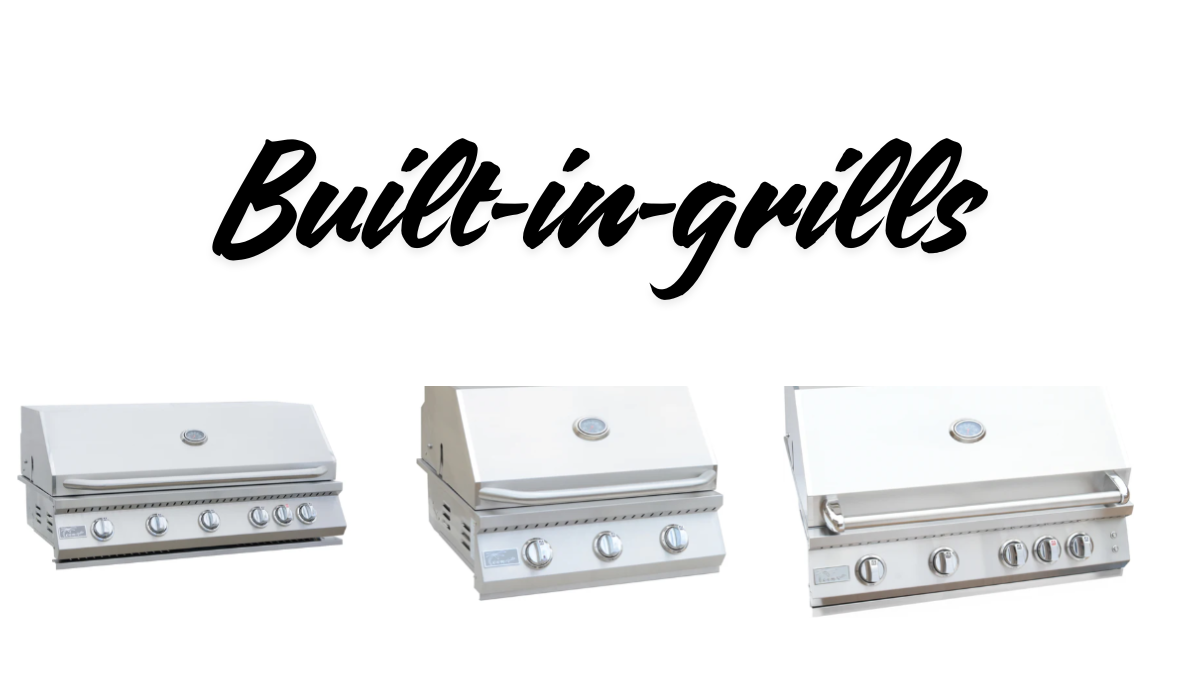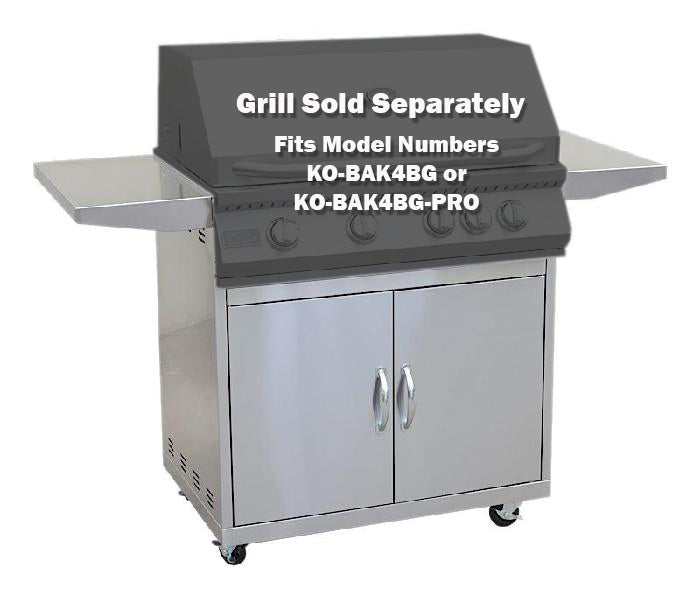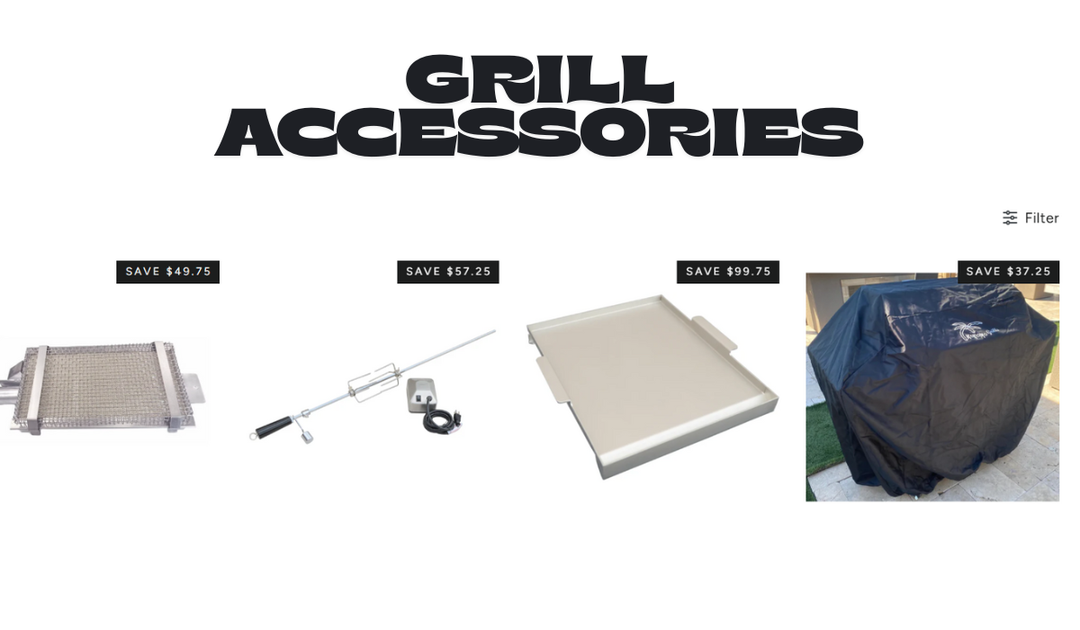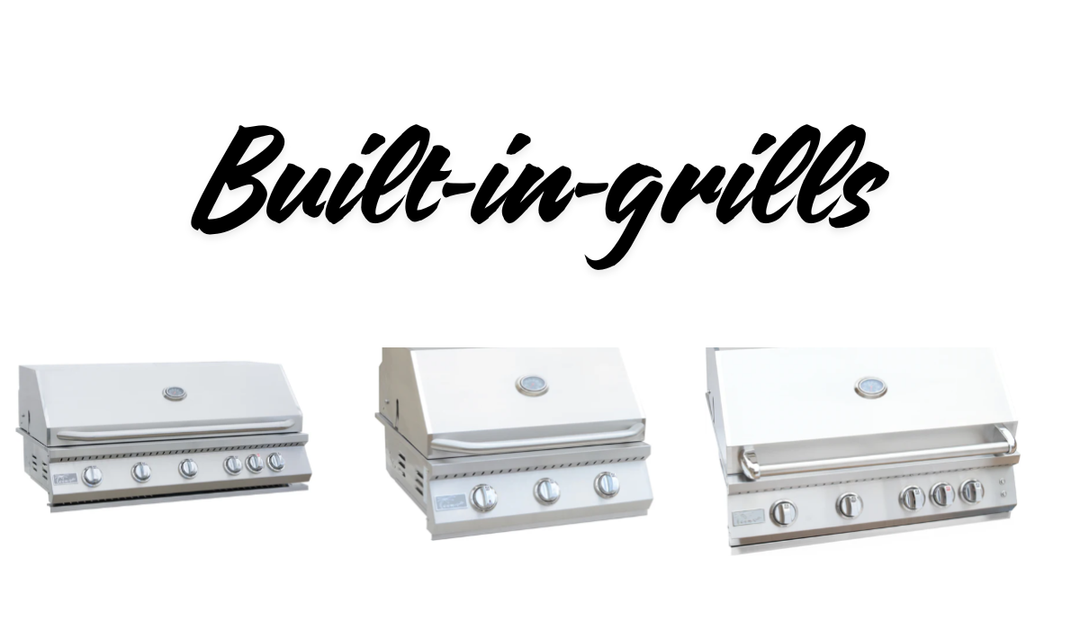Built-In Grills for Pizza Lovers: Best Inserts and Accessories

Pizza perfection begins not in a traditional kitchen oven, but in your backyard where built-in grills transform into versatile pizza-making powerhouses capable of reaching authentic pizzeria temperatures. For pizza enthusiasts investing in outdoor kitchen grills, understanding which inserts and accessories unlock restaurant-quality results separates disappointing experiments from consistently spectacular pies.
The outdoor cooking revolution embraces pizza as much as traditional grilling, with stainless steel outdoor grills and ceramic grills now accommodating specialized pizza stones, oven inserts, and temperature management systems that recreate wood-fired oven conditions. Whether you're designing a complete backyard BBQ setup or upgrading existing outdoor BBQ grills, selecting the right pizza-making equipment elevates your culinary capabilities while maximizing your outdoor kitchen investment.
At Outdoor Fire Haven, we recognize that serious pizza lovers demand equipment delivering authentic results without compromising on convenience, durability, or aesthetic integration within outdoor kitchen designs. This comprehensive guide explores essential pizza inserts, must-have accessories, and expert techniques transforming your built-in grill into the neighborhood's premier pizza destination.
Why Built-In Grills Excel at Pizza Making
Built-in grills offer distinct advantages over freestanding alternatives when pursuing pizza perfection in your backyard BBQ setup. Permanent installation provides stability essential for delicate pizza transfers, while superior insulation and heat retention capabilities generate the intense, sustained temperatures authentic Neapolitan pizza demands.
Temperature Performance and Heat Control
Achieving authentic pizza crust requires cooking temperatures between 600-900°F—far exceeding typical home oven capabilities maxing out around 500°F. Quality outdoor kitchen grills built into permanent structures deliver superior heat retention through thicker construction materials and optimized airflow systems designed specifically for high-temperature applications.
Stainless steel outdoor grills featuring heavy-gauge construction and precision burner systems maintain consistent temperatures throughout extended pizza-making sessions. This reliability proves critical when entertaining guests, allowing you to produce multiple perfect pizzas without dramatic temperature fluctuations between cooks. Cast iron alternatives may offer excellent heat retention but suffer from corrosion issues compromising longevity, while stainless steel withstands harsh outdoor elements while maintaining performance for decades.
Ceramic grills including popular kamado-style cookers provide exceptional temperature stability through thick ceramic wall construction that absorbs and radiates heat evenly. These outdoor BBQ grills naturally create convection currents and radiant heat patterns mimicking traditional wood-fired ovens, producing characteristically blistered crusts and perfectly melted toppings. When configured properly with heat deflectors and pizza stones, ceramic grills transform into specialized pizza ovens rivaling dedicated units costing thousands more.
Space Optimization and Workflow Efficiency
Built-in grill installations within comprehensive backyard BBQ setups optimize workflow through strategic appliance placement and integrated prep surfaces. Unlike freestanding units requiring separate prep areas, built-in configurations position grills adjacent to countertops, refrigeration, and storage—creating efficient pizza assembly lines that professional pizzerias emulate.
This integrated approach means ingredients remain within arm's reach while dough stretches on dedicated prep surfaces and finished pizzas rest on nearby serving areas. For pizza lovers hosting gatherings, this efficiency translates into continuously producing fresh pies without leaving the entertaining space or missing conversations with guests.
Aesthetic Integration and Property Value
Professional built-in outdoor kitchen grills enhance property values through permanent improvements that prospective buyers recognize as premium features. Unlike portable grills representing depreciating assets, quality built-in installations appreciate alongside home values while providing years of reliable service. Stainless steel outdoor grills integrated into stone or masonry structures create focal points that architectural cohesion and visual appeal throughout outdoor living spaces.
Essential Pizza Stone Inserts for Built-In Grills
Pizza stones represent the foundational accessory transforming standard outdoor BBQ grills into legitimate pizza ovens capable of producing crispy, perfectly cooked crusts.
Cordierite vs. Ceramic Pizza Stones
Cordierite pizza stones dominate professional and serious home pizza-making circles through exceptional thermal shock resistance and superior heat distribution properties. These stones withstand dramatic temperature changes—from cold storage to 800°F+ grilling environments—without cracking or fracturing like inferior materials. The mineral composition absorbs moisture from pizza dough, creating authentically crispy bottom crusts while maintaining structural integrity through hundreds of cooking cycles.
Leading manufacturers including Weber, Broil King, and Primo offer cordierite stones specifically sized for popular built-in grill models. These exact-fit designs replace standard cooking grates or position directly on existing surfaces, ensuring proper placement close to heat sources for optimal pizza cooking performance. Cordierite's natural properties mean no seasoning requirements and simple maintenance involving brushing and occasional high-heat cleaning burns.
Ceramic pizza stones provide budget-friendly alternatives delivering good performance for casual pizza makers. While more susceptible to thermal shock and requiring careful preheating procedures, quality ceramic stones produce excellent results when handled properly. The thicker ceramic construction found in premium models offers heat retention approaching cordierite performance at substantially lower price points.
Sizing and Placement Considerations
Matching pizza stone dimensions to your outdoor kitchen grills ensures optimal heat exposure and cooking performance. Rectangular stones replacing multiple cooking grates maximize usable surface area, accommodating larger pizzas or multiple smaller pies simultaneously. Round stones suit kettle-style grills and circular ceramic grills, fitting neatly within heat deflector configurations.
Position pizza stones as close to heat sources as manufacturer recommendations allow without risking damage to grill components. For gas-powered outdoor BBQ grills, placing stones directly above burners—with appropriate clearance preventing direct flame contact—generates intense bottom heat creating signature leopard-spotted crusts characteristic of wood-fired pizzas. Ceramic grills benefit from elevated stone placement using heat deflectors and spacers, creating convection ovens that cook pizza tops and bottoms simultaneously.
Thick vs. Thin Stone Tradeoffs
Pizza stone thickness dramatically impacts preheating time, heat retention, and ultimate crust texture. Thick stones (¾-inch to 1-inch) require 30-45 minutes preheating but maintain stable temperatures throughout cooking sessions and recover quickly between pizzas. This thermal mass suits entertaining scenarios where multiple pizzas cook consecutively, ensuring consistent results from first pie to last.
Thinner stones (½-inch or less) preheat faster—often within 15-20 minutes—making them ideal for weeknight pizza dinners when time is limited. However, reduced thermal mass means more dramatic temperature drops when cold dough contacts the surface, potentially resulting in undercooked centers or pale bottom crusts. For built-in grills in comprehensive backyard BBQ setups used primarily for entertaining, investing in thicker premium stones delivers superior long-term performance.
Pizza Oven Insert Systems for Maximum Performance
Beyond standalone pizza stones, complete oven insert systems transform standard outdoor kitchen grills into dedicated pizza ovens through integrated components optimizing heat circulation, retention, and radiant cooking.
KettlePizza and Universal Insert Systems
KettlePizza pioneered the grill-to-pizza-oven conversion market with stainless steel inserts fitting popular kettle and gas grill models. These systems feature elevated openings directing heat upward while trapping it within cooking chambers, creating dome-like environments similar to traditional brick ovens. Integrated thermometers monitor cooking zone temperatures, while included pizza peels and stones provide complete pizza-making packages.
For three-burner gas outdoor BBQ grills, universal KettlePizza inserts accommodate most standard sizes, transforming $300-800 grills into legitimate pizza ovens for a fraction of dedicated unit costs. The expandable stainless construction adjusts to various grill dimensions while maintaining structural integrity through repeated heating cycles. Multiple burner zones allow temperature customization—running outer burners higher than center creates even heat distribution preventing burnt centers with raw edges.
High-Performance Built-In Pizza Oven Additions
Premium outdoor kitchen grills increasingly integrate purpose-built pizza oven modules within comprehensive backyard BBQ setup designs. Alfresco's Pizza Oven Plus exemplifies this category, featuring thick ceramic hearths and ceilings, dual burner systems, and 15-minute preheat times to operational 900°F temperatures. These dedicated units cook authentic Neapolitan pizzas in three minutes while accommodating bread baking, roasting, and high-heat searing applications.
NewAge Products offers modular built-in pizza ovens engineered to integrate seamlessly with their outdoor kitchen cabinet systems or fit into existing stone structures. Delivering 40,000+ BTU output through dual control burners, these stainless steel outdoor grill components feature insulation blankets and thick cooking stones maintaining 800°F temperatures for rapid consecutive pizza production. Built-in warming drawers keep finished pizzas hot while additional pies cook, and removable crumb chutes simplify cleanup after entertaining.
For comprehensive outdoor kitchen designs, combined grill-and-pizza-oven installations maximize functionality within limited space. Many homeowners position 36-42 inch gas grills alongside dedicated pizza ovens, creating versatile cooking stations handling everything from traditional barbecue to artisan pizzas and wood-fired breads.
Kamado Pizza Accessories and Modifications
Ceramic grills excel at pizza making through natural heat retention and convection properties, with specialized accessories unlocking their full potential. Pizza-Porta represents the category leader, offering kamado modifications specifically designed for extended pizza-making sessions. This insert caps the grill dome while creating front openings for pizza access, maintaining steady temperatures and proper airflow across multiple consecutive cooks.
Standard kamado pizza setups require heat deflectors (plate setters), elevated pizza stone positioning using spacers, and careful vent management maintaining target temperatures. The Pizza-Porta simplifies this process while eliminating common frustrations including temperature swings, smoke infiltration, and difficulty accessing pizzas mid-cook. For serious pizza enthusiasts investing in ceramic grills as primary outdoor kitchen grills, the Pizza-Porta transforms capable cookers into specialized pizza ovens rivaling dedicated commercial units.
Critical Pizza-Making Accessories for Built-In Grill Success
Beyond inserts and stones, strategic accessory selection separates consistently excellent pizzas from frustrating failures and disappointing results.
Pizza Peels: Wooden vs. Metal
Pizza peels—large flat paddles for building and transferring pizzas—represent essential tools no backyard pizza operation survives without. Wooden peels excel at initial pizza building and oven insertion, with natural texture preventing dough from sticking during assembly. The forgiving wooden surface accommodates stretching and shaping, while lighter weight compared to metal alternatives reduces arm fatigue during extended pizza-making sessions.
Metal pizza peels—typically aluminum or stainless steel—serve primarily as turning and removal tools. Their thinner profiles slide easily beneath cooking pizzas without disrupting toppings or dragging against stones. Perforated metal peels shed excess flour before oven insertion, preventing burnt flour taste and smoking during high-temperature cooking. Serious pizza operations require both wooden and metal peels, with wooden handles providing heat insulation protecting hands from radiant oven heat.
Proper peel technique involves generous flour or semolina dusting preventing dough adhesion, quick confident pizza launches preventing mid-air disasters, and periodic shaking during assembly confirming pizzas slide freely before transfer attempts. Many beginners find parchment paper provides insurance against sticking, allowing pizzas to slide reliably onto stones even without perfect technique.
Infrared Thermometers and Monitoring Equipment
Achieving consistent pizza results demands precise temperature knowledge at stone surface level where actual cooking occurs. Standard grill hood thermometers measure ambient dome temperatures often differing 100°F or more from actual cooking surface readings. Infrared thermometers provide instant non-contact surface temperature measurements, ensuring stones reach target ranges before pizza placement.
Quality infrared units accommodate the 700-900°F ranges pizza stones achieve, with laser targeting confirming measurement locations on stone surfaces. This precision allows temperature adjustments before cooking rather than discovering inadequate heat after ruining dough, sauce, and toppings. For outdoor BBQ grills without built-in surface thermometers, infrared measurement represents the difference between guesswork and confident, repeatable results.
Stone Maintenance Tools and Protective Equipment
Pizza stones accumulate baked-on flour, cornmeal, and occasionally cheese or sauce throughout regular use. Dedicated stone brushes featuring sturdy bristles remove debris without scratching surfaces or gouging cordierite material. High-heat cleaning involves running empty outdoor kitchen grills at maximum temperatures, carbonizing residues into ash easily brushed away after cooling.
Never wash pizza stones with soap or submerge them in water—both practices introduce unwanted flavors and compromise stone structural integrity. The porous nature allowing moisture absorption from pizza dough also means stones absorb cleaning products, imparting off-flavors to future pizzas. Simple dry brushing between uses and occasional high-heat burns maintain stones indefinitely without degrading performance.
Heat-resistant gloves rated for 500°F+ protect hands when manipulating hot pizza stones, peels, or adjusting vents on ceramic grills mid-cook. Standard oven mitts prove inadequate for sustained outdoor cooking at pizza-making temperatures, while purpose-designed grilling gloves provide dexterity for detailed work alongside thermal protection.
Optimizing Your Backyard BBQ Setup for Pizza Excellence
Strategic configuration of outdoor kitchen grills and supporting infrastructure creates pizza-making workflows approaching commercial kitchen efficiency.
Prep Surface Location and Sizing
Position dedicated pizza prep counters immediately adjacent to your built-in grill, ideally within single-step reach of stone surfaces. This proximity minimizes pizza transfer time—critical when working with delicate stretched dough susceptible to tearing during movement. Standard outdoor kitchen countertops provide adequate space, though serious pizza operations benefit from extended surfaces accommodating multiple pizzas in various preparation stages.
Stainless steel outdoor grill installations with integrated side prep surfaces simplify single-cook pizza making, while comprehensive backyard BBQ setups featuring 6-8 feet of continuous counter space support party-scale production. Consider removable cutting boards sized for standard pizza diameters (12-16 inches), allowing guests to customize personal pizzas before transferring to peels for cooking.
Ingredient Storage and Refrigeration Proximity
Fresh pizza ingredients—particularly cheeses and proteins—require refrigeration until assembly moments before cooking. Outdoor kitchen refrigerators positioned within your built-in grill work triangle eliminate indoor trips while maintaining optimal ingredient temperature and food safety. Undercounter refrigerator drawers integrate cleanly into island designs, providing 4-6 cubic feet storage sufficient for typical pizza party needs.
For budget-conscious backyard BBQ setups, insulated coolers filled with ice serve as effective temporary ingredient storage, though lacking the convenience and temperature control of dedicated outdoor refrigeration. Position ingredient storage to your dominant-hand side if possible, streamlining assembly workflows and reducing cross-body reaching during repetitive pizza building.
Lighting for Evening Pizza Sessions
Pizza-making sessions frequently extend into evening hours when natural light fades, making adequate artificial lighting essential for proper dough inspection, topping distribution, and doneness evaluation. Overhead task lighting mounted on pergola structures or dedicated light posts illuminates prep surfaces without creating glare on stainless steel outdoor grill surfaces.
LED strip lighting beneath countertop overhangs provides glare-free illumination ideal for detailed work including stretching dough and applying toppings. Many modern outdoor kitchen grills integrate halogen or LED oven lights within pizza oven units, allowing visual monitoring without opening doors and losing critical heat. For ceramic grills without built-in lighting, handheld flashlights or headlamps enable proper doneness inspection without excessive dome lifting.
Stainless Steel vs. Ceramic Grills for Pizza Lovers
Choosing between stainless steel outdoor grills and ceramic grills depends on your specific pizza-making priorities, budget constraints, and broader outdoor cooking goals.
Stainless Steel Outdoor Grill Advantages
Stainless steel construction delivers unmatched weather resistance, maintaining performance and appearance through years of outdoor exposure in even harsh coastal or humid climates. Unlike cast iron alternatives rusting rapidly, quality stainless steel outdoor BBQ grills featuring 304 or 316 grade materials withstand rain, snow, salt air, and temperature extremes without corrosion or structural degradation.
The superior heat distribution properties of stainless steel eliminate frustrating hot spots plaguing lower-quality grills, ensuring pizzas cook evenly regardless of stone placement. Quick temperature response allows rapid adjustments when pizzas begin browning too quickly or need additional bottom crust development. For backyard BBQ setups emphasizing versatility—alternating between traditional grilling and pizza making—gas-powered stainless steel outdoor grills provide instant-on convenience and predictable performance.
Maintenance requirements remain minimal, with stainless steel surfaces resisting marinades, sauces, and high-acidity tomato products without staining or pitting. Simple soap-and-water cleaning maintains appearance, while the material's non-reactive nature ensures no flavor transfer between different cooking applications. For pizza lovers also enjoying traditional barbecue, steaks, seafood, and vegetables, stainless steel versatility accommodates diverse cooking styles without specialized setup requirements.
Ceramic Grill Benefits for Pizza Purists
Ceramic grills including Big Green Egg, Kamado Joe, and Vision models recreate wood-fired oven conditions more authentically than gas alternatives through charcoal combustion and superior heat retention. The thick ceramic walls absorb and radiate heat creating convection currents that cook pizza tops and bottoms simultaneously—difficult achieving with standard gas outdoor kitchen grills requiring separate broiler elements.
Temperature stability throughout extended cooking sessions means the 15th pizza cooks identically to the first, with minimal fuel additions maintaining steady heat for hours. This consistency proves invaluable during parties where continuous pizza production over 2-3 hours is expected. The subtle wood smoke character from lump charcoal imparts authentic flavor impossible replicating with gas burners, satisfying pizza purists seeking traditional taste profiles.
However, ceramic grills demand longer preheating periods (30-45 minutes versus 10-15 minutes for gas), more involved temperature management learning curves, and careful handling preventing thermal shock cracks. For outdoor BBQ grill installations primarily focused on pizza making and occasional smoking applications, ceramic cookers deliver unmatched results justifying their limitations. Those seeking broader outdoor cooking functionality with minimal learning curves typically find stainless steel outdoor grills more accommodating.
Assembling Your Complete Pizza-Making Arsenal
Creating the ultimate pizza-focused backyard BBQ setup requires methodical accessory accumulation based on priorities and budget realities.
Beginner Pizza-Making Starter Kit
New pizza enthusiasts entering outdoor cooking should begin with essential basics ensuring immediate success without overwhelming investment. A quality cordierite pizza stone sized appropriately for your outdoor kitchen grills represents the foundational purchase—budget $60-120 for reputable brands delivering years of reliable service. One wooden pizza peel with adequate handle length (12-14 inches) handles all building and launching duties, costing $25-50 for solid construction.
An infrared thermometer ($20-40) removes temperature guesswork, while heavy-duty heat-resistant gloves ($15-25) protect during stone handling and vent adjustments. This $120-235 initial investment transforms existing outdoor BBQ grills into capable pizza ovens without requiring specialized inserts or expensive modifications. Master fundamental techniques including proper dough handling, efficient topping application, and temperature management before expanding your arsenal.
Intermediate Setup Enhancements
After achieving consistent results with basic equipment, strategic upgrades address specific challenges and expand capabilities. A metal pizza peel ($30-60) with perforated design improves pizza turning and removal while preventing burnt flour accumulation. Pizza oven inserts like KettlePizza systems ($150-300) optimize heat distribution and extend cooking chamber capabilities for gas outdoor BBQ grills.
For ceramic grill owners, dedicated accessories including heat deflector plates ($50-100), elevated stone supports ($20-40), and Pizza-Porta modifications ($200-300) unlock maximum pizza-making potential. Multiple pizza stones allow prebaking par-cooked crusts on one stone while finishing pizzas on another—a professional technique accelerating party pizza production. Combined intermediate investments of $250-700 dramatically improve consistency, expand throughput, and reduce frustration during learning curve navigation.
Advanced Professional-Grade Equipment
Serious pizza enthusiasts committed to outdoor entertaining justify premium investments delivering commercial-kitchen capabilities. Dedicated built-in pizza ovens from manufacturers including Alfresco, NewAge, or Fontana transform backyard BBQ setups into authentic pizzeria operations capable of 60-second Neapolitan pies at 900°F+ temperatures. These specialized units cost $2,000-8,000 installed but provide unmatched performance, reliability, and social focal points justifying their expense for frequent entertainers.
Professional pizza peel sets including multiple sizes and materials ($100-250), commercial-grade stone brushes and maintenance tools ($30-80), and precision digital thermometers with multiple probes ($80-150) complete world-class setups. Specialized pizza-themed outdoor kitchen accessories including dough proofing boxes, semolina/flour dispensers, and ingredient prep trays optimize workflows approaching commercial efficiency. Total advanced arsenal investments of $2,500-10,000+ create outdoor kitchens rivaling restaurant capabilities while serving as property value enhancements appreciating alongside home values.
Frequently Asked Questions About Built-In Grills and Pizza Making
Can any built-in grill make good pizza?
Most outdoor kitchen grills can produce acceptable pizza with appropriate accessories, though performance varies dramatically based on grill type and configuration. Gas-powered stainless steel outdoor grills require pizza stones and possibly oven inserts achieving authentic results, while ceramic grills naturally excel at pizza making through superior heat retention and convection properties. Built-in grills featuring higher BTU outputs, quality construction materials, and precise temperature control deliver better pizza outcomes than budget alternatives.
What temperature should I cook pizza at on my outdoor grill?
Target cooking temperatures between 600-750°F for home-style pizzas with thicker crusts, while authentic Neapolitan thin-crust pizzas require 800-900°F stone temperatures. Most outdoor BBQ grills accommodate the 600-750°F range comfortably with proper preheating and stone placement, while reaching 800°F+ demands specialized equipment or oven inserts concentrating heat. Use infrared thermometers measuring actual stone surface temperatures rather than relying on hood thermometers reading ambient dome temperatures.
How long does it take to preheat a pizza stone on a built-in grill?
Preheating duration depends on stone thickness and grill type—standard ½-inch stones require 15-25 minutes, while thick ¾-inch+ professional stones need 30-45 minutes reaching proper temperatures. Ceramic grills typically demand longer preheating periods (30-45 minutes minimum) than gas outdoor kitchen grills (15-25 minutes) due to ceramic thermal mass requiring heating. Never place cold pizza stones directly on hot grills—always preheat stones alongside grills preventing thermal shock cracks.
Do I need special pizza dough for outdoor grill cooking?
Pizza dough formulations should match your target cooking temperature—higher-temperature ovens (700°F+) benefit from lower-sugar doughs preventing excessive browning, while moderate temperatures (500-650°F) accommodate standard recipes including sugars and oils promoting browning. Most pizzeria dough works excellently on backyard BBQ setups, though hydration levels may require minor adjustments based on your local humidity and flour types. Experiment with purchased dough from local pizzerias before investing time developing homemade recipes.
What's better for pizza: gas or charcoal built-in grills?
Gas-powered outdoor kitchen grills provide convenience, precise temperature control, and faster preheating ideal for weeknight pizza dinners and users prioritizing ease over tradition. Charcoal and wood-fired ceramic grills deliver authentic smoky flavor, superior heat retention, and convection patterns mimicking traditional wood ovens—preferred by pizza purists willing to accept longer setup times and steeper learning curves. Both produce excellent pizzas when configured properly with appropriate accessories.
Can I use my pizza stone for regular grilling?
Pizza stones accommodate various applications beyond pizza including bread baking, vegetable roasting, and even bacon cooking. However, avoid high-fat meats directly on stones—grease absorption causes smoking during subsequent high-temperature pizza cooking and permanently taints stone flavor profiles. Use pizza stones primarily for pizza, breads, and low-fat applications while reserving standard grill grates for proteins and fatty foods.
How do I clean my pizza stone after cooking?
Allow pizza stones to cool completely before cleaning—rapid temperature changes cause cracking. Use stiff brushes removing baked-on debris without water or soap, both of which compromise stone integrity and introduce off-flavors. For stubborn buildup, run empty outdoor BBQ grills at maximum temperature 10-15 minutes, carbonizing residues into easily-brushed ash. Never submerge pizza stones in water or clean with detergents—simple dry brushing maintains stones indefinitely.
Are stainless steel outdoor grills worth the extra cost?
Quality stainless steel outdoor grills justify premium pricing through superior durability, weather resistance, even heat distribution, and minimal maintenance requirements. Unlike lower-cost alternatives rusting or corroding within seasons, 304/316 stainless steel withstands decades of outdoor exposure while maintaining performance and appearance. For permanent backyard BBQ setups representing long-term investments, stainless steel construction provides best value despite higher initial costs.
Elevate Your Pizza Game with the Right Built-In Grill Setup
Transforming your outdoor kitchen grills into authentic pizza-making powerhouses requires strategic equipment selection combining quality built-in grills, essential accessories, and proper technique development. Whether investing in premium stainless steel outdoor grills offering versatile cooking capabilities or specialized ceramic grills delivering unmatched pizza performance, the right configuration turns backyard gatherings into memorable culinary experiences rivaling favorite pizzerias.
Success begins with understanding your priorities—convenience versus tradition, versatility versus specialization, budget constraints versus long-term value. Gas-powered outdoor BBQ grills provide accessible entry points for pizza exploration while accommodating traditional grilling, whereas ceramic alternatives reward committed pizza enthusiasts with authentic wood-fired results. Regardless of your chosen path, proper accessories including quality pizza stones, reliable peels, and accurate temperature monitoring separate consistent excellence from frustrating inconsistency.
Explore Outdoor Fire Haven's built-in grills collection featuring premium stainless steel outdoor grills, ceramic cookers, and comprehensive accessories supporting your pizza-making ambitions. Your backyard BBQ setup awaits transformation into the neighborhood's premier pizza destination—where every gathering features authentically delicious, restaurant-quality pies made possible through proper equipment and passionate technique.




